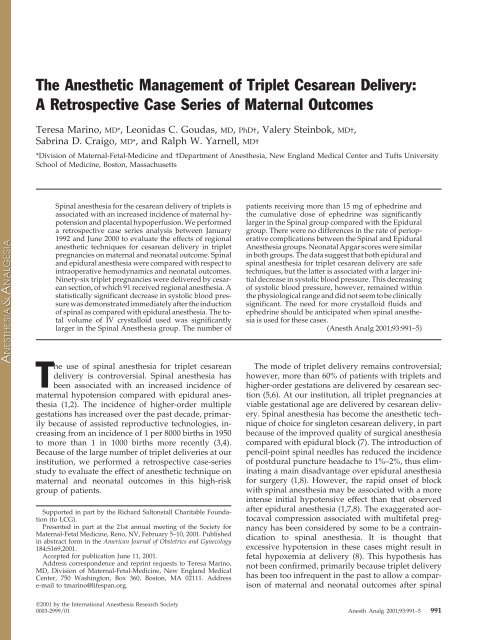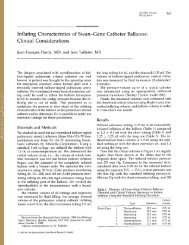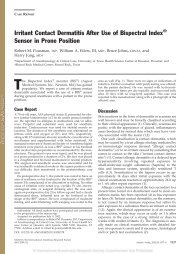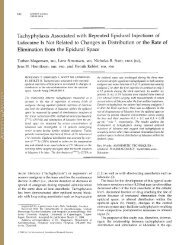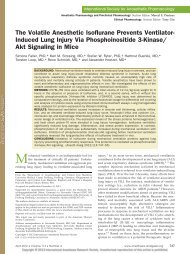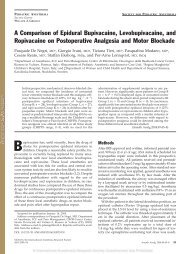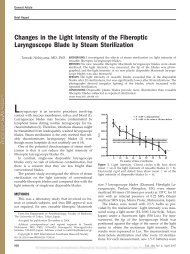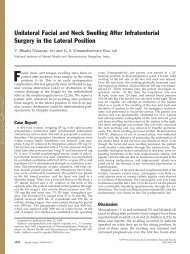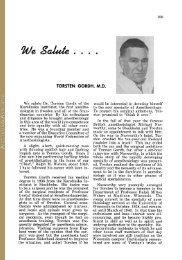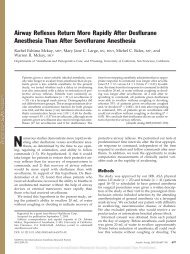The Anesthetic Management of Triplet Cesarean Delivery: A ...
The Anesthetic Management of Triplet Cesarean Delivery: A ...
The Anesthetic Management of Triplet Cesarean Delivery: A ...
Create successful ePaper yourself
Turn your PDF publications into a flip-book with our unique Google optimized e-Paper software.
<strong>The</strong> <strong>Anesthetic</strong> <strong>Management</strong> <strong>of</strong> <strong>Triplet</strong> <strong>Cesarean</strong> <strong>Delivery</strong>:<br />
A Retrospective Case Series <strong>of</strong> Maternal Outcomes<br />
Teresa Marino, MD*, Leonidas C. Goudas, MD, PhD†, Valery Steinbok, MD†,<br />
Sabrina D. Craigo, MD*, and Ralph W. Yarnell, MD†<br />
*Division <strong>of</strong> Maternal-Fetal-Medicine and †Department <strong>of</strong> Anesthesia, New England Medical Center and Tufts University<br />
School <strong>of</strong> Medicine, Boston, Massachusetts<br />
Spinal anesthesia for the cesarean delivery <strong>of</strong> triplets is<br />
associated with an increased incidence <strong>of</strong> maternal hypotension<br />
and placental hypoperfusion. We performed<br />
a retrospective case series analysis between January<br />
1992 and June 2000 to evaluate the effects <strong>of</strong> regional<br />
anesthetic techniques for cesarean delivery in triplet<br />
pregnancies on maternal and neonatal outcome. Spinal<br />
and epidural anesthesia were compared with respect to<br />
intraoperative hemodynamics and neonatal outcomes.<br />
Ninety-six triplet pregnancies were delivered by cesarean<br />
section, <strong>of</strong> which 91 received regional anesthesia. A<br />
statistically significant decrease in systolic blood pressure<br />
was demonstrated immediately after the induction<br />
<strong>of</strong> spinal as compared with epidural anesthesia. <strong>The</strong> total<br />
volume <strong>of</strong> IV crystalloid used was significantly<br />
larger in the Spinal Anesthesia group. <strong>The</strong> number <strong>of</strong><br />
<strong>The</strong> use <strong>of</strong> spinal anesthesia for triplet cesarean<br />
delivery is controversial. Spinal anesthesia has<br />
been associated with an increased incidence <strong>of</strong><br />
maternal hypotension compared with epidural anesthesia<br />
(1,2). <strong>The</strong> incidence <strong>of</strong> higher-order multiple<br />
gestations has increased over the past decade, primarily<br />
because <strong>of</strong> assisted reproductive technologies, increasing<br />
from an incidence <strong>of</strong> 1 per 8000 births in 1950<br />
to more than 1 in 1000 births more recently (3,4).<br />
Because <strong>of</strong> the large number <strong>of</strong> triplet deliveries at our<br />
institution, we performed a retrospective case-series<br />
study to evaluate the effect <strong>of</strong> anesthetic technique on<br />
maternal and neonatal outcomes in this high-risk<br />
group <strong>of</strong> patients.<br />
Supported in part by the Richard Saltonstall Charitable Foundation<br />
(to LCG).<br />
Presented in part at the 21st annual meeting <strong>of</strong> the Society for<br />
Maternal-Fetal Medicine, Reno, NV, February 5–10, 2001. Published<br />
in abstract form in the American Journal <strong>of</strong> Obstetrics and Gynecology<br />
184:S169,2001.<br />
Accepted for publication June 11, 2001.<br />
Address correspondence and reprint requests to Teresa Marino,<br />
MD, Division <strong>of</strong> Maternal-Fetal-Medicine, New England Medical<br />
Center, 750 Washington, Box 360, Boston, MA 02111. Address<br />
e-mail to tmarino@lifespan.org.<br />
patients receiving more than 15 mg <strong>of</strong> ephedrine and<br />
the cumulative dose <strong>of</strong> ephedrine was significantly<br />
larger in the Spinal group compared with the Epidural<br />
group. <strong>The</strong>re were no differences in the rate <strong>of</strong> perioperative<br />
complications between the Spinal and Epidural<br />
Anesthesia groups. Neonatal Apgar scores were similar<br />
in both groups. <strong>The</strong> data suggest that both epidural and<br />
spinal anesthesia for triplet cesarean delivery are safe<br />
techniques, but the latter is associated with a larger initial<br />
decrease in systolic blood pressure. This decreasing<br />
<strong>of</strong> systolic blood pressure, however, remained within<br />
the physiological range and did not seem to be clinically<br />
significant. <strong>The</strong> need for more crystalloid fluids and<br />
ephedrine should be anticipated when spinal anesthesia<br />
is used for these cases.<br />
(Anesth Analg 2001;93:991–5)<br />
<strong>The</strong> mode <strong>of</strong> triplet delivery remains controversial;<br />
however, more than 60% <strong>of</strong> patients with triplets and<br />
higher-order gestations are delivered by cesarean section<br />
(5,6). At our institution, all triplet pregnancies at<br />
viable gestational age are delivered by cesarean delivery.<br />
Spinal anesthesia has become the anesthetic technique<br />
<strong>of</strong> choice for singleton cesarean delivery, in part<br />
because <strong>of</strong> the improved quality <strong>of</strong> surgical anesthesia<br />
compared with epidural block (7). <strong>The</strong> introduction <strong>of</strong><br />
pencil-point spinal needles has reduced the incidence<br />
<strong>of</strong> postdural puncture headache to 1%–2%, thus eliminating<br />
a main disadvantage over epidural anesthesia<br />
for surgery (1,8). However, the rapid onset <strong>of</strong> block<br />
with spinal anesthesia may be associated with a more<br />
intense initial hypotensive effect than that observed<br />
after epidural anesthesia (1,7,8). <strong>The</strong> exaggerated aortocaval<br />
compression associated with multifetal pregnancy<br />
has been considered by some to be a contraindication<br />
to spinal anesthesia. It is thought that<br />
excessive hypotension in these cases might result in<br />
fetal hypoxemia at delivery (8). This hypothesis has<br />
not been confirmed, primarily because triplet delivery<br />
has been too infrequent in the past to allow a comparison<br />
<strong>of</strong> maternal and neonatal outcomes after spinal<br />
©2001 by the International Anesthesia Research Society<br />
0003-2999/01 Anesth Analg 2001;93:991–5 991
992 OBSTETRIC ANESTHESIA MARINO ET AL. ANESTH ANALG<br />
ANESTHESIA FOR TRIPLETS 2001;93:991–5<br />
versus epidural anesthesia. <strong>The</strong> objective <strong>of</strong> this retrospective<br />
case-series analysis was to identify the risks<br />
and benefits <strong>of</strong> these two neuraxial anesthetic techniques<br />
for triplet cesarean delivery on the basis <strong>of</strong><br />
maternal and neonatal outcomes.<br />
Methods<br />
All cases <strong>of</strong> triplet pregnancies delivered by cesarean<br />
section at New England Medical Center from July<br />
1992 to June 2000 were reviewed. Patients were identified<br />
from our triplet database and confirmed from<br />
our delivery room logbook. Data were collected from<br />
the patients’ prenatal, anesthetic, and discharge<br />
records. <strong>The</strong> neonatal records for each triplet were<br />
also reviewed.<br />
Antenatal maternal complications were documented.<br />
<strong>The</strong> anesthetic management, perioperative<br />
maternal hemodynamics, and neonatal outcomes<br />
were compared between groups on the basis <strong>of</strong> the<br />
type <strong>of</strong> regional anesthesia performed. Patients who<br />
delivered before 24 wk gestation, those with a demise<br />
<strong>of</strong> one or more fetuses, or those who delivered vaginally<br />
were excluded. Decisions regarding the choice <strong>of</strong><br />
anesthetic technique, anesthetic drugs, perioperative<br />
IV fluid administration, and the frequency <strong>of</strong> vasopressor<br />
use were made by the anesthesiologist involved<br />
in the case. Lidocaine 2% with epinephrine<br />
(1:200,000) was the local anesthetic used in all epidural<br />
cases and was supplemented with fentanyl or meperidine.<br />
Hyperbaric bupivacaine (0.75% in dextrose) was<br />
used in all the spinal anesthetics, with meperidine<br />
10–20 mg added to the solution in all cases (9,10).<br />
Sensory block extending from T4 to T6 by pinprick<br />
was confirmed before the incision. <strong>The</strong> small number<br />
<strong>of</strong> patients in the General Anesthesia group (n 5)<br />
were included for demographic comparison only.<br />
Data in tables and figures are presented as percentage<br />
or mean sem. Statistical analysis <strong>of</strong> continuous<br />
variables was performed with multiple analysis <strong>of</strong><br />
variance (ANOVA) followed by post hoc analysis, with<br />
Dunn’s test for pairwise comparison between groups.<br />
Dichotomous variables were compared by using the<br />
2 test. <strong>The</strong> Apgar scores are presented as binomials.<br />
<strong>The</strong> statistical comparison <strong>of</strong> Apgar scores was performed<br />
at 1 and 5 min for the same neonate in the<br />
order <strong>of</strong> delivery between the groups using Kruskal-<br />
Wallis one-way ANOVA on ranks. Differences were<br />
considered statistically significant at P 0.05.<br />
Results<br />
From January 1992 to June 2000, there were 96 triplet<br />
cesarean deliveries at New England Medical Center, a<br />
tertiary care center. Seventy-one patients had spinal,<br />
20 had epidural, and 5 had general anesthesia. Maternal<br />
age, maternal weight, and mean gestational age at<br />
time <strong>of</strong> cesarean delivery were similar between<br />
groups. Eighty-six <strong>of</strong> the 96 (89.6%) triplet pregnancies<br />
were the result <strong>of</strong> assisted reproductive technology.<br />
<strong>The</strong> indications for delivery did not differ significantly<br />
between regional anesthesia groups (Table 1). <strong>The</strong>re<br />
were no cases <strong>of</strong> general anesthesia or epidural anesthesia<br />
after 1997 (Fig. 1). In this 8-yr period, there was<br />
one case <strong>of</strong> regional anesthesia failure (both epidural<br />
and spinal approaches attempted) followed by general<br />
anesthesia. Indications for general anesthesia included<br />
severe preeclampsia with coagulopathy and nonreassuring<br />
fetal heart rate tracing (Table 1).<br />
Of the 96 women with triplet pregnancies, 83<br />
(86.5%) required antenatal admission for longer than<br />
24 h. <strong>The</strong> most common complication <strong>of</strong> triplet pregnancy<br />
was preterm labor, occurring in 81.2% <strong>of</strong> patients.<br />
Pregnancy-induced hypertension was also common,<br />
occurring in 32.3% <strong>of</strong> our admitted patients. Of<br />
the patients diagnosed with pregnancy-induced hypertension,<br />
more than 50% met criteria for severe preeclampsia,<br />
HELLP syndrome (hemolysis, elevated<br />
liver tests, and low platelets), or coagulopathy (Table<br />
2). Acute fatty liver <strong>of</strong> pregnancy occurred in 4.2% <strong>of</strong><br />
our patients.<br />
<strong>The</strong> IV fluid volume used before the induction <strong>of</strong><br />
anesthesia (preload) did not differ between the Spinal<br />
and Epidural groups. <strong>The</strong> total volume <strong>of</strong> IV crystalloid<br />
used was 2.5 0.09 L in the Spinal group and 2.1<br />
0.1 L in the Epidural group (P 0.05). After the<br />
induction <strong>of</strong> regional anesthesia, systolic blood pressure<br />
was 110.3 2.5 in the Spinal Anesthesia group<br />
and 127.3 4.0 in the Epidural group at the same time<br />
point (P 0.05) (Fig. 2A). <strong>The</strong>se differences were not<br />
clinically significant. No other differences in systolic<br />
blood pressures were noted between the regional<br />
groups. <strong>The</strong>re were no differences in mean arterial<br />
pressures, diastolic pressures, or heart rate between<br />
the regional anesthesia groups. Ephedrine was successfully<br />
used as a pressor drug at the time <strong>of</strong> surgery<br />
when necessary to maintain blood pressure. <strong>The</strong> number<br />
<strong>of</strong> patients who required the administration <strong>of</strong><br />
more than 15 mg <strong>of</strong> ephedrine over the entire case was<br />
larger in the Spinal Anesthesia group than the Epidural<br />
Anesthesia group (50 vs 6 patients, P 0.0011).<br />
In addition, the total dose <strong>of</strong> ephedrine was significantly<br />
larger in the Spinal Anesthesia group compared<br />
with the Epidural group (20 21.3 mg vs 4.75 <br />
8.37 mg, P 0.001).<br />
<strong>The</strong>re were no intraoperative anesthesia complications<br />
recorded for any <strong>of</strong> the groups. Postoperative<br />
complications were similar among the three anesthesia<br />
groups. <strong>The</strong> total estimated blood loss was similar<br />
in the Spinal and Epidural Anesthesia groups (0.98 <br />
0.04 L vs 0.94 0.06 L).
ANESTH ANALG OBSTETRIC ANESTHESIA MARINO ET AL. 993<br />
2001;93:991–5 ANESTHESIA FOR TRIPLETS<br />
Table 1. Indications for <strong>Cesarean</strong> <strong>Delivery</strong><br />
Indication Spinal (n 71) Epidural (n 20) General (n 5)<br />
Preterm labor 33 (47.8) 11 (55) 0<br />
Premature rupture <strong>of</strong> membranes 8 (11.3) 3 (15) 0<br />
Preeclampsia 13 (18.3) 4 (20) 0<br />
Preeclampsia with coagulopathy 0 0 2 (40)<br />
Acute fatty liver 3 (4.2) 0 1 (20)<br />
Term gestation a<br />
7 (9.9) 2 (10) 0<br />
Nonreassuring fetal HR tracing 6 (8.5) 0 2 (40)<br />
Data are presented as n (%).<br />
HR heart rate.<br />
a Patients delivered at 37 wk gestation.<br />
Figure 1. Number <strong>of</strong> patients that received spinal, epidural, or<br />
general anesthesia for triplet delivery with cesarean section from<br />
July 1992 through June 2000 at New England Medical Center Hospital.<br />
Each bar represents the number <strong>of</strong> triplet deliveries performed<br />
with cesarean section during a 1-yr period starting in July and<br />
ending with June.<br />
<strong>The</strong>re were no differences in gestational age at delivery<br />
or birth weight between the two groups. Apgar<br />
scores at 1 and 5 min were compared for all neonates<br />
between each anesthetic group and for subgroups <strong>of</strong><br />
neonates according to the order <strong>of</strong> delivery (first, second,<br />
or third). <strong>The</strong>re was no statistically significant<br />
difference in the Apgar scores at 1 and 5 min. Of the<br />
samples measured, there was no difference in umbilical<br />
cord blood pH results between the two groups.<br />
However, because the umbilical cord gases were collected<br />
in fewer than half <strong>of</strong> these cases, these were<br />
excluded from any further analysis.<br />
Discussion<br />
<strong>The</strong>re is a growing preference for regional anesthesia<br />
for cesarean birth in the United States (7), not only<br />
because it avoids the risks <strong>of</strong> failed intubation and<br />
aspiration, but also because these patients prefer to be<br />
awake, experience less sedation and better analgesia<br />
postoperatively (10), and to participate in the delivery<br />
Table 2. Complications <strong>of</strong> <strong>Triplet</strong> Gestations<br />
Complication n (%)<br />
Antenatal complications 83 (86.5)<br />
Preterm labor (34 wk) 78 (81.2)<br />
Premature rupture <strong>of</strong> membranes 17 (17.7)<br />
Pregnancy-induced hypertension 31 (32.3)<br />
Mild preeclampsia 18 (18.8)<br />
Severe preeclampsia 18 (18.8)<br />
HELLP syndrome 5 (5.2)<br />
Eclampsia 1 (1)<br />
Acute fatty liver <strong>of</strong> pregnancy 4 (4.2)<br />
Gestational diabetes 7 (7.3)<br />
Anemia 15 (15.6)<br />
Supraventricular tachycardia 3 (3.1)<br />
Pruritic urticarial plaques and papules <strong>of</strong><br />
pregnancy<br />
4 (4.2)<br />
Acute lumbar disc prolapse 1 (1)<br />
Postpartum complications 23 (24.0)<br />
Endometritis 14 (14.9)<br />
Hemorrhage 6 (6.2)<br />
Disseminated intravascular coagulopathy 2 (2)<br />
Postpartum readmission 8 (8.3)<br />
Pneumonia 2 (2)<br />
HELLP hemolysis, elevated liver tests, and low platelets.<br />
<strong>of</strong> their newborns. <strong>The</strong> increased safety <strong>of</strong> regional<br />
anesthetic techniques was demonstrated by Hawkins<br />
et al. (11), who reported that from 1985 to 1990, the<br />
case fatality rate directly attributed to anesthesia was<br />
approximately 17-fold more frequent with general anesthesia<br />
as compared with regional anesthesia. <strong>The</strong><br />
fact that fewer than 10% <strong>of</strong> cesarean deliveries are now<br />
performed under general anesthesia (12) underscores<br />
the strong preference for regional blocks among caregivers<br />
and patients alike. This is the first case series <strong>of</strong><br />
triplet deliveries that supports the safe use <strong>of</strong> both<br />
spinal and epidural anesthetic techniques in these<br />
cases.<br />
<strong>The</strong> use <strong>of</strong> spinal anesthesia for singleton cesarean<br />
delivery has increased significantly over the past several<br />
years, partly because <strong>of</strong> the introduction <strong>of</strong> atraumatic,<br />
pencil-point spinal needles (1,7,8). Figure 1 demonstrates<br />
a similar trend in this series <strong>of</strong> triplet cesarean deliveries.<br />
Spinal anesthesia has the benefit <strong>of</strong> producing regional<br />
anesthesia more rapidly and perhaps more reliably than<br />
epidural anesthesia for cesarean delivery (13). Patients
994 OBSTETRIC ANESTHESIA MARINO ET AL. ANESTH ANALG<br />
ANESTHESIA FOR TRIPLETS 2001;93:991–5<br />
Figure 2. Perioperative changes in arterial blood pressures. Systolic<br />
(SAP) (A) and mean (MAP) (B) arterial pressure. After the induction<br />
<strong>of</strong> regional anesthesia, there was a significant decrease <strong>of</strong> the systolic<br />
blood pressure in the Spinal Anesthesia group compared with<br />
the Epidural group at the same time point. Data are presented as<br />
mean sem (one-way analysis <strong>of</strong> variance, post hoc Dunn’s test for<br />
pairwise comparisons, *P 0.05).<br />
receiving spinal anesthesia are more comfortable during<br />
surgery and require less supplemental intraoperative<br />
analgesia (12). <strong>The</strong> incremental dosing <strong>of</strong> the epidural<br />
catheter during the initiation <strong>of</strong> epidural anesthesia may<br />
enable better control <strong>of</strong> the dermatomal distribution <strong>of</strong><br />
the sympathetic block and produces a slower onset <strong>of</strong><br />
action (8,12). <strong>The</strong>se factors may reduce the incidence and<br />
severity <strong>of</strong> maternal hypotension compared with spinal<br />
block (12). In addition, spinal anesthesia produces a<br />
greater spread <strong>of</strong> block with multifetal pregnancy as<br />
compared with singleton patients undergoing cesarean<br />
delivery (14). This may also contribute to an increase <strong>of</strong><br />
maternal hypotension and uterine hypoperfusion in<br />
multifetal pregnancy. Proposed mechanisms accounting<br />
for the greater increase in anesthetic spread observed in<br />
multifetal pregnancies include obstructed venous return,<br />
larger reduction <strong>of</strong> cerebrospinal fluid volumes, and increased<br />
concentrations <strong>of</strong> progesterone (14,15). Some investigators<br />
suggest that the spinal anesthetic technique is<br />
associated with fewer complications and is more cost<br />
effective in singleton pregnancies (13).<br />
Our observations suggest that with adequate hydration<br />
and the administration <strong>of</strong> ephedrine, hypotension<br />
after spinal block for triplet birth can be safely managed.<br />
Brief episodes <strong>of</strong> hypotension were not associated<br />
with any significant effect on the neonates, and<br />
no significant difference in Apgar scores was noted<br />
between the two groups. It should be stressed that the<br />
retrospective analysis in the present case series cannot<br />
exclude the possibility <strong>of</strong> a deliberate use <strong>of</strong> increased<br />
prehydration in women who received spinal anesthesia.<br />
<strong>The</strong> need for increased IV crystalloid fluids and<br />
ephedrine to avoid maternal hypotension should be<br />
anticipated when spinal anesthesia is used (1,8).<br />
<strong>The</strong> last general anesthetic performed in this series<br />
was in April 1997. This may represent narrowing indications<br />
for general anesthesia in obstetrics, as well as<br />
earlier preemptive management <strong>of</strong> maternal and fetal<br />
antenatal complications, thereby preventing urgency<br />
or other contraindications to regional anesthesia.<br />
<strong>The</strong> incidence <strong>of</strong> maternal comorbidity with triplet<br />
gestations is substantially more frequent than in singleton<br />
pregnancy (5,16) (Table 2). Pregnancy-induced<br />
hypertension, the most common maternal antenatal<br />
complication in our patients, carries a 7% incidence in<br />
singleton pregnancy and up to 20% incidence in twin<br />
gestations (16). Thus, it is not surprising that the incidence<br />
<strong>of</strong> pregnancy-induced hypertension in our triplet<br />
case series was 32.3%. Acute fatty liver <strong>of</strong> pregnancy,<br />
a potentially life-threatening condition that<br />
occurs with an incidence <strong>of</strong> approximately 1 in<br />
10,000 deliveries (16), occurred in 4.2% <strong>of</strong> our patients.<br />
This review <strong>of</strong> our experience with triplet birth is<br />
subject to the usual criticisms <strong>of</strong> retrospective reviews.<br />
Lack <strong>of</strong> randomization may have introduced bias, particularly<br />
in the choice <strong>of</strong> patients receiving each type<br />
<strong>of</strong> anesthesia. Lack <strong>of</strong> standardization <strong>of</strong> anesthetic<br />
techniques may have introduced unmeasured confounders.<br />
<strong>The</strong> passage <strong>of</strong> time may have introduced<br />
changes in obstetric and anesthetic approaches that<br />
have influenced these results (7,8).<br />
This is the largest case series <strong>of</strong> anesthetic experience<br />
with triplet cesarean birth and demonstrates the<br />
safety <strong>of</strong> spinal and epidural anesthetic techniques in<br />
this patient population.<br />
References<br />
1. Reisner LS, Lin D. Anesthesia for cesarean section. In: Chestnut<br />
DH, ed. Obstetric anesthesia: principles and practice. 2nd ed. St.<br />
Louis: Mosby Inc, 1999:465–92.<br />
2. Clark RB, Thompson CH. Prevention <strong>of</strong> spinal hypotension<br />
associated with cesarean section. Anesthesiology 1976;45:670–4.<br />
3. Jewell SE, Yip R. Increasing trends <strong>of</strong> pleural births in the<br />
United States. Obstet Gynecol 1995;85:229–32.<br />
4. Contribution <strong>of</strong> assisted reproductive technology and<br />
ovulation-inducing drugs to triplet and higher-order multiple<br />
births: United States, 1980–1997. MMWR Morb Mortal Wkly<br />
Rep 2000;49:535–8.<br />
5. Malone FD, Kaufman GE, Chelmow D, et al. Maternal morbidity<br />
associated with triplet pregnancy. Am J Perinatol 1998;15:<br />
73–7.
ANESTH ANALG OBSTETRIC ANESTHESIA MARINO ET AL. 995<br />
2001;93:991–5 ANESTHESIA FOR TRIPLETS<br />
6. Wildschut HI, van Roosmalen J, van Leeuwen E, et al. Planned<br />
abdominal compared with planned vaginal birth in triplet pregnancies.<br />
Br J Obstet Gynaecol 1995;102:292–6.<br />
7. Hawkins JL, Gibbs CP, Orleans M, et al. Obstetric anesthesia<br />
work force survey, 1981 versus 1992. Anesthesiology 1997;87:<br />
135–43.<br />
8. Shnider SM, Levinson G. Anesthesia for cesarean section. In:<br />
Shnider SM, Levinson G, eds. Anesthesia for obstetrics. 3rd ed.<br />
Williams and Wilkins, 1993:211–46.<br />
9. Sangarlangkarn S, Klaewtanong V, Jonglerttrakool P, Khankaew<br />
V. Meperidine as a spinal anesthetic agent: a comparison<br />
with lidocaine-glucose. Anesth Analg 1987;66:235–40.<br />
10. Yarnell RW, Polis T, Reid GN, et al. Patient-controlled analgesia<br />
with epidural meperidine after elective cesarean section. Reg<br />
Anesth 1992;17:329–33.<br />
11. Hawkins JL, Koonin LM, Palmer SK, Gibbs CP. Anesthesiarelated<br />
deaths during obstetric delivery in the United States,<br />
1979–1990. Anesthesiology 1997:86:277–84.<br />
12. Hawkins JL, Beatty BR, Gibbs CP. Update on obstetrical anesthesia<br />
practices in the United States [abstract presented at <strong>The</strong><br />
Society <strong>of</strong> Obstetric Anesthesia and Perinatology]. Anesthesiology<br />
1999;(Suppl):A53.<br />
13. Riley ET, Cohen SE, Macario A, et al. Spinal versus epidural<br />
anesthesia for cesarean section: a comparison <strong>of</strong> time efficiency,<br />
costs, charges, and complications. Anesth Analg 1995;80:709–12.<br />
14. Jawan B, Lee JH, Chong ZK, Chang CS. Spread <strong>of</strong> spinal anaesthesia<br />
for caesarean section in singleton and twin pregnancies.<br />
Br J Anaesth 1993;70:639–41.<br />
15. Jawan B, Lee JH. <strong>The</strong> effect <strong>of</strong> removal <strong>of</strong> CSF on cephalad<br />
spread <strong>of</strong> spinal with bupivacaine. Acta Anaesthesiol Scand<br />
1990;34:452–4.<br />
16. Malone FD, D’Alton ME. Multiple gestation: clinical characteristics<br />
and management. In: Creasy RK, Resnik R, eds. Maternalfetal<br />
medicine: principles and practice. 4th ed. Philadelphia:<br />
Saunders, 1998:598–615.


